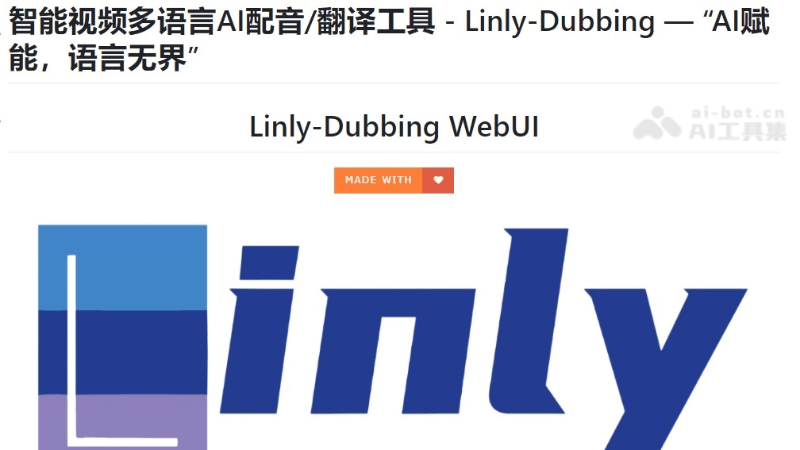Linly-Dubbing
Linly-Dubbing is an open-source AI video tool that supports dubbing, translation, and lip-syncing, automatically translating video content into multiple languages and generating subtitles.
What is Linly-Dubbing?
Linly-Dubbing is an open-source AI video translation and dubbing tool that supports dubbing, translation, and lip-syncing. It can automatically translate video content into multiple languages and generate subtitles. Using WhisperX and FunASR for accurate speech recognition and Edge TTS, XTTS, and CosyVoice for high-quality speech synthesis, Linly-Dubbing ensures natural and accurate video dubbing. It leverages OpenAI API and Qwen models for subtitle translation and employs voice separation and lip-syncing technologies to make video dubbing smooth and precise. Users can upload videos, select translation languages, and achieve personalized multilingual dubbing, making it easy to internationalize video content with Linly-Dubbing.
Main Features of Linly-Dubbing
- Multilingual Support: Provides dubbing and subtitle translation services in Chinese and other languages to meet the needs of different language markets.
- AI Speech Recognition: Uses WhisperX and FunASR technology for accurate speech-to-text conversion, including speaker recognition.
- AI Speech Synthesis: Integrates Edge TTS, XTTS, and CosyVoice tools to generate natural and smooth voice output, supporting voice cloning.
- AI Subtitle Translation: Uses OpenAI API, Qwen models, and Google Translate to ensure accurate and natural translations.
- Voice Separation: Can separate human voices from background music, facilitating video post-production.
- Lip-Syncing: Based on Linly-Talker technology, it achieves precise matching of virtual character lip movements with dubbing, enhancing video realism.
- Video Processing: Users can upload videos and customize subtitles, background music, volume, and playback speed to increase video appeal.
How to Use Linly-Dubbing
- Environment Preparation: Ensure that Python is installed on your computer. Install the required dependency libraries and tools.
- Get the Code: Visit the Linly-Dubbing GitHub repository. Clone or download the project's source code locally.
- Install Dependencies: Follow the project documentation to install all necessary Python dependency packages.
- Configure Environment: Set up environment variables, which may include API keys, model paths, etc.
- Download AI Models: Download and load the required AI models, such as speech recognition, translation, and speech synthesis models.
- Use the Web Interface: Start the project's web user interface.
- Upload Video: Upload the video file you want to translate and dub through the web interface.
Linly-Dubbing Project Address
- GitHub Repository: https://github.com/Kedreamix/Linly-Dubbing
Target Users of Linly-Dubbing
- Content Creators: Individuals or teams who need to translate video content into different languages to attract a global audience.
- Educational Institutions: Schools or online education platforms that want to localize teaching materials for students in different countries and regions.
- Video Production Companies: Production teams that need to add multilingual dubbing to films, animations, documentaries, etc.
- Corporate Marketing Departments: Companies that need to translate product introductions, training materials, etc., into multiple languages to expand into international markets.
- Social Media Influencers: Social media users who want to increase their fan base and engagement in different language regions.
Features & Capabilities
What You Can Do
Video Dubbing
Subtitle Translation
Lip-Syncing
Voice Separation
Speech Recognition
Speech Synthesis
Categories
AI Video Tool
Dubbing
Translation
Lip-Syncing
Multilingual Support
Speech Recognition
Speech Synthesis
Subtitle Translation
Voice Separation
Video Processing
Example Uses
- Content creators translating videos for global audiences
- Educational institutions localizing teaching materials
- Video production companies adding multilingual dubbing
- Corporate marketing departments translating product introductions
- Social media influencers increasing engagement in different language regions
Getting Started
Pricing
free
Requirements
- Python
- Dependency libraries and tools
- AI models for speech recognition, translation, and synthesis
Screenshots & Images
Primary Screenshot

Additional Images

